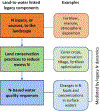Advancing Watershed Legacy Nitrogen Modeling to Improve Global Water Quality
- PMID: 36800391
- PMCID: PMC10478509
- DOI: 10.1021/acs.est.2c06983
Advancing Watershed Legacy Nitrogen Modeling to Improve Global Water Quality
Abstract
Despite widespread implementation of watershed nitrogen reduction programs across the globe, nitrogen levels in many surface waters remain high. Watershed legacy nitrogen storage, i.e., the long-term retention of nitrogen in soils and groundwater, is one of several explanations for this lack of progress. However scientists and water managers are ill-equipped to estimate how legacy nitrogen moderates in-stream nitrogen responses to land conservation practices, largely because modeling tools and associated long-term monitoring approaches to answering these questions remain inadequate. We demonstrate the need for improved watershed models to simulate legacy nitrogen processes and offer modeling solutions to support long-term nitrogen-based sustainable land management across the globe.
Keywords: hydrology; legacy nitrogen; nitrogen; nutrient management; watershed modeling.
Figures


References
-
- Bowles TM; Atallah SS; Campbell EE; Gaudin ACM; Wieder WR; Grandy AS Addressing agricultural nitrogen losses in a changing climate. Nature Sustainability 2018, 1 (8), 399–408, DOI: 10.1038/s41893-018-0106-0 - DOI
-
- Grizzetti B; Bouraoui F; Billen G; van Grinsven H; Cardoso AC; Thieu V; Garnier J; Curtis C; Howarth R; Johnes P. Nitrogen as a threat to European water quality. In The European Nitrogen Assessment: Sources, Effects and Policy Perspectives; Bleeker A, Grizzetti B, Howard CM, Billen G, van Grinsven H, Erisman JW, Sutton, Grennfelt P, Eds.; Cambridge University Press: Cambridge, U.K., 2011; pp 379–404.
-
- Wurtsbaugh WA; Paerl HW; Dodds WK Nutrients, eutrophication and harmful algal blooms along the freshwater to marine continuum. Wiley Interdisciplinary Reviews: Water 2019, DOI: 10.1002/wat2.1373 - DOI
-
- The Nitrates Directive. 1991/676/EEC; European Commission, 1991.
Publication types
MeSH terms
Substances
Grants and funding
LinkOut - more resources
Full Text Sources

